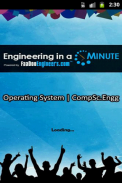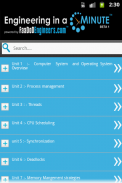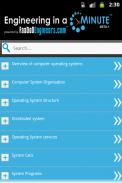






Operating System - OS

Perihal Operating System - OS
Welcome to an exciting world of operating system (O/S). The Basics of Operating System is a free app with listing of notes on the introduction of the OS and covers the basics of how system software works
Usually a part of computer science, software engineering, programming and information technology courses but open for all enthusiasts to learn the basics.
The App covers more than 125 topics on the subject divided into 14 units.
The App brings all the interesting topics in a flashcard which is easy to browse, revise and come back to another topic to learn. Some of topics Covered in this application are:
1. Overview of computer operating systems
2. Computer System Organization
3. Operating System Structure
4. Distributed system
5. Operating System services
6. System Calls
7. System Programs
8. Operating System Generation
9. Operating-System Services
10. Operating-System Interface
11. Process Management
12. Process Control Block
13. Schedulers
14. Context switch
15. Operations on Processes
16. Interprocess Communication
17. Sockets
18. Remote Procedure Calls
19. Remote method invocation
20. Threads
21. Scheduling Criteria
22. Scheduling Algorithms
23. Multithreading Models
24. Thread Libraries
25. Threading Issues
26. CPU scheduling
27. Multiple-Processor Scheduling
28. Symmetric Multithreading
29. Thread Scheduling
30. Solaris Scheduling
31. Windows XP Scheduling
32. Linux Scheduling
33. Algorithm Evaluation
34. Process Synchronization
35. The Critical Section Problem
36. Synchronization Hardware
37. Semaphores
38. Classic problems of synchronization
39. Monitors
40. Atomic Transactions
41. Deadlocks
42. Deadlock Characterization
43. Methods for handling deadlocks
44. Deadlock Prevention
45. Deadlock Avoidance
46. Banker’s algorithm
47. Deadlock Detection
48. Recovery from Deadlock
49. Memory Management Strategies
50. Address Binding
51. Logical versus Physical Address Space
52. Dynamic Linking and Loading
53. Swapping
54. Contiguous Memory Allocation
55. Fragmentation
56. Paging
57. Hardware Support in paging
58. Shared Pages
59. Segmentation
60. Virtual memory
61. System libraries
62. Demand Paging
63. Copy-on-Write
64. Page Replacement
65. FIFO Page Replacement
66. Optimal Page Replacement
67. LRU Page Replacement
68. Enhanced Second-Chance Algorithm
69. Allocation of Frames
70. Thrashing
71. Working-Set Model
72. Page-Fault Frequency
73. Memory-Mapped Files
74. Shared Memory in the Win32 API
75. Allocating Kernel Memory
76. Slab Allocation
77. File Concept
78. File Operations
79. File Types
80. Directory Structure
81. Directory
82. File System Mounting
83. File System Structure
84. File System Implementation
85. Directory Implementation
86. Free Space Management
87. Recovery
88. Log-Structured File Systems
89. Network file systems
90. Network file systems protocol
91. Magnetic Disks
92. Disk Structure
93. Disk Attachment
94. Disk Scheduling
95. Disk Management
96. Boot Block
97. Bad Blocks
98. Swap-Space Management
99. I/O Systems
100. Polling
101. Direct Memory Access
102. Application I/O Interface
103. Kernel I/O Subsystem
104. Transforming I/O Requests to Hardware Operations
105. Streams
106. Performance
107. Protection
108. Access Matrix
109. Implementation of Access Matrix
110. Access Control
111. Language-Based Protection
112. The Security Problem
113. Malicious codes
114. System and Network Threats
115. Cryptography as a Security Tool
116. Authentication
117. Key Distribution
118. User Authentication
119. Firewalling to Protect Systems and Networks
IMPORTANT LINKS
Feedback: Share your feedback at essyengineering@gmail.com
Social links
Facebook : https://www.facebook.com/EngineeringEasy/
Twitter : https://twitter.com/easyengineerin
Website:http://www.engineeringapps.net/
Wishing you a very happy learning
</div> <div jsname="WJz9Hc" style="display:none">Selamat datang ke dunia yang menarik sistem operasi (O / S). Perkara Asas Sistem Operasi adalah aplikasi percuma dengan senarai nota mengenai pengenalan OS dan meliputi asas-asas bagaimana perisian sistem kerja-kerja
Biasanya sebahagian daripada sains komputer, kejuruteraan perisian, kursus pengaturcaraan dan teknologi maklumat tetapi terbuka untuk semua peminat untuk mempelajari asas-asas.
App meliputi lebih daripada 125 topik mengenai subjek ini dibahagikan kepada 14 unit.
App membawa semua topik menarik dalam flashcard yang mudah untuk melayari, menyemak semula dan kembali ke topik yang lain untuk belajar. Antara topik yang dibincangkan dalam permohonan ini adalah:
1. Gambaran keseluruhan sistem operasi komputer
2. Organisasi Sistem Komputer
Struktur 3. Sistem pengendalian
4. Sistem Teragih
5. Perkhidmatan Sistem pengendalian
6. Panggilan Sistem
7. Program Sistem
8. Sistem pengendalian Generation
9. Operasi-System Services
10. Operasi-System Interface
Pengurusan 11. Proses
12. Proses Sekat Kawalan
13. penjadual
suis 14. Konteks
15. Operasi pada Proses
16. Interprocess Komunikasi
17. Soket
18. Panggilan Prosedur Remote
19. Remote kaedah doa
20. Threads
21. Kriteria Penjadualan
22. Penjadualan Algoritma
23. Model Multithreading
24. Perpustakaan Thread
25. Isu Threading
penjadualan 26. CPU
27. Multiple-Processor Penjadualan
28. Simetri Multithreading
29. Thread Penjadualan
30. Solaris Penjadualan
31. Windows XP Penjadualan
32. Linux Penjadualan
33. Algoritma Penilaian
34. Proses Penyegerakan
35. The Critical Seksyen Masalah
36. Penyegerakan Hardware
37. semaphores
38. masalah Classic penyegerakan
39. Monitor
40. Urusniaga Atom
41. kebuntuan
42. Kebuntuan Pencirian
43. Kaedah untuk kebuntuan pengendalian
44. Pencegahan Kebuntuan
45. Kebuntuan Pengelakan
46. Bankerà ¢ â,¬â "¢ s algoritma
Pengesanan 47. Kebuntuan
48. Pemulihan daripada Kebuntuan
49. Strategi Pengurusan Memori
50. Alamat mengikat
51. Logical berbanding Fizikal Ruang Alamat
52. Dynamic Menghubungkan dan Loading
53. Pertukaran
54. Bersempadanan Peruntukan Memory
55. Pemecahan
56. Paging
57. Perkakasan Sokongan dalam paging
58. Laman Perkongsian
59. Segmentasi
60. memori Maya
61. perpustakaan Sistem
62. Permintaan Paging
63. Salinan-on-Write
64. Page Penggantian
65. FIFO Page Penggantian
66. Optimal Page Penggantian
67. LRU Page Penggantian
Algoritma Peluang Kedua-68. Enhanced
69. Peruntukan Frames
70. penggelupur
71. Kerja-set Model
Kekerapan 72. Page-Fault
73. Memory-dipetakan Files
74. Memori Bersama dalam API gdi32.dll
Memory 75. Memperuntukkan Kernel
76. Slab Peruntukan
Concept 77. Fail
78. Operasi Fail
79. Jenis Fail
Struktur 80. Direktori
81. Direktori
Sistem 82 Fail pemasangan
83 Fail Struktur Sistem
Sistem 84 Fail Pelaksanaan
85. Direktori Pelaksanaan
86. Pengurusan Space Percuma
87. Pemulihan
88. Log-Berstruktur Sistem Fail
89. sistem fail Network
90. Rangkaian protokol sistem fail
91. Cakera magnet
Struktur 92. Disk
93. Disk Lampiran
94. Disk Penjadualan
Pengurusan 95. Disk
96. Boot Block
97. Bad Blok
Pengurusan 98. Swap-Space
99. I / O Systems
100. polling
101. Direct Access Memory
102. Permohonan I / O antara muka
103. Kernel I / O Subsistem
104. Transformasi I / O Permintaan untuk Operasi Perkakasan
105. Streams
106. Prestasi
107. Perlindungan
108. Akses Matrix
109. Pelaksanaan Akses Matrix
Kawalan 110. Access
111. Bahasa Berasaskan Perlindungan
112. Keselamatan Masalah
113. Kod berniat jahat
114. Sistem dan Rangkaian Ancaman
115. Kriptografi sebagai Alat Keselamatan
116. Pengesahan
117. Pengagihan Key
Pengesahan 118. Pengguna
119. firewalling Melindungi Sistem dan Rangkaian
PAUTAN PENTING
Maklum balas: Kongsi maklum balas anda di essyengineering@gmail.com
pautan sosial
Facebook: https://www.facebook.com/EngineeringEasy/
Twitter: https://twitter.com/easyengineerin
Laman Web: http: //www.engineeringapps.net/
Selamat Menyambut pembelajaran sangat gembira</div> <div class="show-more-end">


























